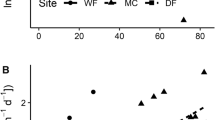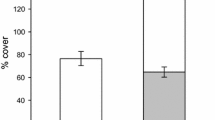Abstract
Plant–soil interactions have been proposed as a causative mechanism explaining how invasive plant species impact ecosystem processes. We evaluate whether an invasive plant influences plant and soil-microbe acquisition of nitrogen to elucidate the mechanistic pathways by which invaders might alter N availability. Using a 15N tracer, we quantify differences in nitrogen uptake and allocation in communities with and without Microstegium vimineum, a shade-tolerant, C4 grass that is rapidly invading the understories of eastern US deciduous forests. We further investigate if plants or the microbial biomass exhibit preferences for certain nitrogen forms (glycine, nitrate, and ammonium) to gain insight into nitrogen partitioning in invaded communities. Understory native plants and M. vimineum took up similar amounts of added nitrogen but allocated it differently, with native plants allocating primarily to roots and M. vimineum allocating most nitrogen to shoots. Plant nitrogen uptake was higher in invaded communities due primarily to the increase in understory biomass when M. vimineum was present, but for the microbial biomass, nitrogen uptake did not vary with invasion status. This translated to a significant reduction (P < 0.001) in the ratio of microbial biomass to plant biomass nitrogen uptake, which suggests that, although the demand for nitrogen has intensified, microbes continue to be effective nitrogen competitors. The microbial biomass exhibited a strong preference for ammonium over glycine and nitrate, regardless of invasion status. By comparison, native plants showed no nitrogen preferences and M. vimineum preferred inorganic nitrogen species. We interpret our findings as evidence that invasion by M. vimineum leads to changes in the partitioning of nitrogen above and belowground in forest understories, and to decreases in the microbial biomass, but it does not affect the outcome of plant–microbe–nitrogen interactions, possibly due to functional shifts in the microbial community as a result of invasion.




Similar content being viewed by others
References
Allison SD, Vitousek PM (2004) Rapid nutrient cycling in leaf litter from invasive plants in Hawai’i. Oecologia 141:612–619
Andersson T (1993) Significance of foliar nutrient absorption in nutrient-rich low-light environments as indicated by Mercurialis perennis. Flora 187:429–433
Ashton IW, Hyatt LA, Howe KM, Gurevitch J, Lerdau MT (2005) Invasive species accelerate decomposition and litter nitrogen loss in a mixed deciduous forest. Ecol Appl 15:1263–1272
Bever JD et al (2010) Rooting theories of plant community ecology in microbial interactions. Trends Ecol Evol 25:468–478
Bradford MA et al (2008) Thermal adaptation of soil microbial respiration to elevated temperature. Ecol Lett 11:1316–1327
Bradford MA, DeVore JL, Maerz JC, McHugh JV, Smith CL, Strickland MS (2010) Native, insect herbivore communities derive a significant proportion of their carbon from a widespread invader of forest understories. Biol. Invasions 12:721–724
Cabrera ML, Beare MH (1993) Alkaline persulfate oxidation for determining total nitrogen in microbial biomass extracts. Soil Sci Soc Am J 57:1007–1012
Callaway RM, Thelen GC, Rodriguez A, Holben WE (2004) Soil biota and exotic plant invasion. Nature 427:731–733
Carlisle A, Brown AHF, White EJ (1967) The nutrient content of tree stem flow and ground flora litter and leachates in a sessile oak (Quercus petraea) woodland. J Ecol 55:615–627
Chapin FS, McFarland J, McGuire AD, Euskirchen ES, Ruess RW, Kielland K (2009) The changing global carbon cycle: linking plant–soil carbon dynamics to global consequences. J Ecol 97:840–850
Claridge K, Franklin SB (2002) Compensation and plasticity in an invasive plant species. Biol Invasions 4:339–347
Cole PG, Weltzin JF (2005) Light limitation creates patchy distribution of an invasive grass in eastern deciduous forests. Biol Invasions 7:477–488
Collins B, Wein G (1998) Soil resource heterogeneity effects on early succession. Oikos 82:238–245
Crawley MJ (1987) What makes a community invasible? In: Gray AJ, Crawley MJ, Edwards PJ (eds) Colonization, succession and stability. Blackwell, Oxford, pp 429–453
DeMeester JE, Richter DD (2010) Differences in wetland nitrogen cycling between the invasive grass Microstegium vimineum and a diverse plant community. Ecol Appl 20:609–619
Ehleringer JR, Monson RK (1993) Evolutionary and ecological aspects of photosynthetic pathway variation. Annu Rev Ecol Syst 24:411–439
Ehrenfeld JG (2003) Effects of exotic plant invasions on soil nutrient cycling processes. Ecosystems 6:503–523
Ehrenfeld JG, Kourtev P, Huang WZ (2001) Changes in soil functions following invasions of exotic understory plants in deciduous forests. Ecol Appl 11:1287–1300
Ehrenfeld JG, Ravit B, Elgersma K (2005) Feedback in the plant–soil system. Annu Rev Environ Resour 30:75–115
Fierer N, Schimel JP (2002) Effects of drying-rewetting frequency on soil carbon and nitrogen transformations. Soil Biol Biochem 34:777–787
Fierer N, Schimel JP (2003) A proposed mechanism for the pulse in carbon dioxide production commonly observed following the rapid rewetting of a dry soil. Soil Sci Soc Am J 67:798–805
Flory SL, Clay K (2010) Non-native grass invasion alters native plant composition in experimental communities. Biol Invasions 12:1285–1294
Fry B (2006) Stable isotope ecology. Springer, New York
Gagnon D, Lafond A, Amiot LP (1958) Mineral nutrient content of some forest plant leaves and of the humus layer as related to site quality. Can J Bot 36:209–220
Geisseler D, Horwath WR, Joergensen RG, Ludwig B (2010) Pathways of nitrogen utilization by soil microorganisms: a review. Soil Biol Biochem 42:2058–2067
Gilbert B, Lechowicz MJ (2005) Invasibility and abiotic gradients: the positive correlation between native and exotic plant diversity. Ecology 86:1848–1855
Gilliam FS (2007) The ecological significance of the herbaceous layer in temperate forest ecosystems. Bioscience 57:845–858
Harrison KA, Bol R, Bardgett RD (2007) Preferences for different nitrogen forms by coexisting plant species and soil microbes. Ecology 88:989–999
Hawkes CV, Wren IF, Herman DJ, Firestone MK (2005) Plant invasion alters nitrogen cycling by modifying the soil nitrifying community. Ecol Lett 8:976–985
Hodge A, Robinson D, Fitter A (2000) Are microorganisms more effective than plants at competing for nitrogen? Trends Plant Sci 5:304–308
Hogberg P, Read DJ (2006) Towards a more plant physiological perspective on soil ecology. Trends Ecol Evol 21:548–554
Horton JL, Neufeld HS (1998) Photosynthetic responses of Microstegium vimineum (Trin.) A. Camus, a shade-tolerant, C4 grass, to variable light environments. Oecologia 114:11–19
Howard TG, Gurevitch J, Hyatt L, Carreiro M, Lerdau M (2004) Forest invasibility in communities in southeastern New York. Biol Invasions 6:393–410
Inderjit, van der Putten WH (2010) Impacts of soil microbial communities on exotic plant invasions. Trends Ecol Evol 25:512–519
Kaye JP, Hart SC (1997) Competition for nitrogen between plants and soil microorganisms. Trends Ecol Evol 12:139–143
Knops JMH, Bradley KL, Wedin DA (2002) Mechanisms of plant species impacts on ecosystem nitrogen cycling. Ecol Lett 5:454–466
Kourtev PS, Ehrenfeld JG, Haggblom M (2002) Exotic plant species alter the microbial community structure and function in the soil. Ecology 83:3152–3166
Kourtev PS, Ehrenfeld JG, Haggblom M (2003) Experimental analysis of the effect of exotic and native plant species on the structure and function of soil microbial communities. Soil Biol Biochem 35:895–905
Levine JM, Vila M, D’Antonio CM, Dukes JS, Grigulis K, Lavorel S (2003) Mechanisms underlying the impacts of exotic plant invasions. Proc R Soc Lond B 270:775–781
Liao CZ et al (2008) Altered ecosystem carbon and nitrogen cycles by plant invasion: a meta-analysis. New Phytol 177:706–714
Martin PH (1999) Norway maple (Acer platanoides) invasion of a natural forest stand: understory consequence and regeneration pattern. Biol Invasions 1:215–222
Martin PH, Sherman RE, Fahey TJ (2004) Forty years of tropical forest recovery from agriculture: Structure and floristics of secondary and old-growth riparian forests in the Dominican Republic. Biotropica 36:297–317
Martin PH, Canham CD, Marks PL (2009) Why forests appear resistant to exotic plant invasions: intentional introductions, stand dynamics, and the role of shade tolerance. Front Ecol Environ 7:142–149
Miller AE, Bowman WD, Suding KN (2007) Plant uptake of inorganic and organic nitrogen: neighbor identity matters. Ecology 88:1832–1840
Morrison JA, Lubchansky HA, Mauck KE, McCartney KM, Dunn B (2007) Ecological comparison of two co-invasive species in eastern deciduous forests: Alliaria petiolata and Microstegium vimineum. J Torrey Bot 134:1–17
Muller RN (2003) Nutrient relations of the herbaceous layer in deciduous forest ecosystems. In: Gilliam FS, Roberts MR (eds) The herbaceous layer in forests of Eastern North America. Oxford University Press, New York, pp 15–37
Oswalt CM, Oswalt SN, Clatterbuck WK (2007) Effects of Microstegium vimineum (Trin.) A. Camus on native woody species density and diversity in a productive mixed-hardwood forest in Tennessee. For Ecol Manag 242:727–732
Pollierer MM, Langel R, Korner C, Maraun M, Scheu S (2007) The underestimated importance of belowground carbon input for forest soil animal food webs. Ecol Lett 10:729–736
Rodgers VL, Wolfe BE, Werden LK, Finzi AC (2008) The invasive species Alliaria petiolata (garlic mustard) increases soil nutrient availability in northern hardwood-conifer forests. Oecologia 157:459–471
Schimel JP, Bennett J (2004) Nitrogen mineralization: challenges of a changing paradigm. Ecology 85:591–602
Scott NA, Saggar S, McIntosh PD (2001) Biogeochemical impact of Hieracium invasion in New Zealand’s grazed tussock grasslands: sustainability implications. Ecol Appl 11:1311–1322
Siccama TG, Bormann FH, Likens GE (1970) Hubbard Brook ecosystem study: productivity, nutrients, and phytosociology of the herbaceous layer. Ecol Monogr 40:389–402
Strickland MS, DeVore JL, Maerz JC, Bradford MA (2010) Grass invasion of a hardwood forest is associated with declines in belowground carbon pools. Glob Change Biol 16:1338–1350
Strickland M, DeVore J, Maerz J, Bradford M (2011) Loss of faster-cycling soil carbon pools following grass invasion across multiple forest sites. Soil Biol Biochem 43:452–454
USDA and NRCS (2005) The PLANTS database. Version 3.5. Data compiled from various sources by Mark W. Skinner. National Plant Data Center, Baton Rouge
Vitousek PM (1990) Biological invasions and ecosystem processes: towards an integration of population biology and ecosystem studies. Oikos 57:7–13
Von Holle B, Delcourt HR, Simberloff D (2003) The importance of biological inertia in plant community resistance to invasion. J Veg Sci 14:425–432
Warren R, Wright J, Bradford M (2011a) The putative niche requirements and landscape dynamics of Microstegium vimineum: an invasive Asian grass. Biol Invasions 13:471–483
Warren RJ, Bahn V, Kramer TD, Tang Y, Bradford MA (2011b) Performance and reproduction of an exotic invader across temperate forest gradients. Ecosphere 2:14
Webb SL, Kaunzinger CK (1993) Biological invasion of the Drew University (New Jersey) Forest Preserve by Norway Maple (Acer platanoides L.). Bull Torrey Bot 120:343–349
Webb SL, Dwyer M, Kaunzinger CK, Wyckoff PH (2000) The myth of the resilient forest: case study of the invasive Norway maple (Acer platanoides). Rhodora 102:332–354
Woods KD (1993) Effects of invasion by Lonicera tatarica L. on herbs and tree seedlings in 4 New England forests. Am Midl Nat 130:62–74
Yarie J (1980) The role of understory vegetation in the nutrient cycle of forested ecosystems in the Mountain Hemlock Biogeoclimatic Zone. Ecology 61:1498–1514
Acknowledgments
This study benefitted from discussions with Robert Warren, Tony Yannarell and Monica Turner. We also thank K. Gross and three anonymous reviewers for their comments. Funding was through the Long-Term Ecological Research (LTER) Program of the National Science Foundation (Grants DEB-0823293 and DEB-9632854) and the Andrew W. Mellon Foundation. The work conducted complied with all current laws and regulations of the US, where the study was conducted.
Author information
Authors and Affiliations
Corresponding author
Additional information
Communicated by Tim Seastedt.
Rights and permissions
About this article
Cite this article
Fraterrigo, J.M., Strickland, M.S., Keiser, A.D. et al. Nitrogen uptake and preference in a forest understory following invasion by an exotic grass. Oecologia 167, 781–791 (2011). https://doi.org/10.1007/s00442-011-2030-0
Received:
Accepted:
Published:
Issue Date:
DOI: https://doi.org/10.1007/s00442-011-2030-0




